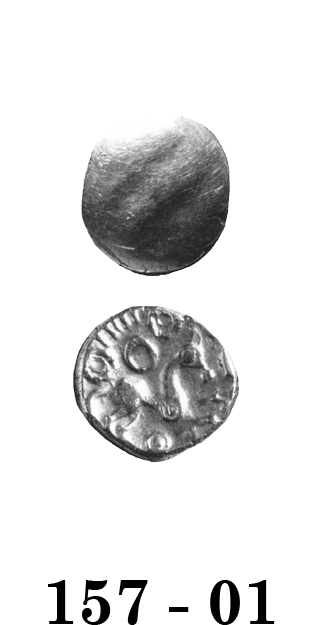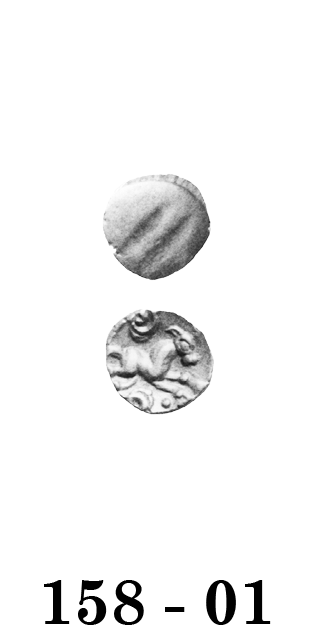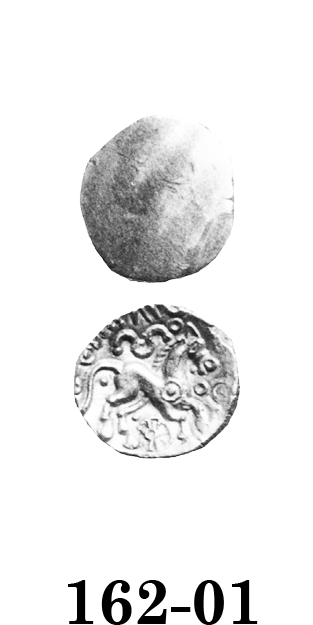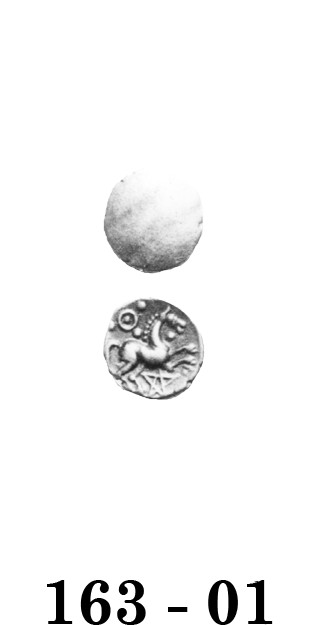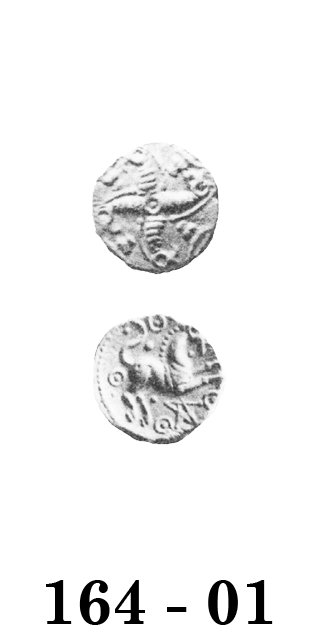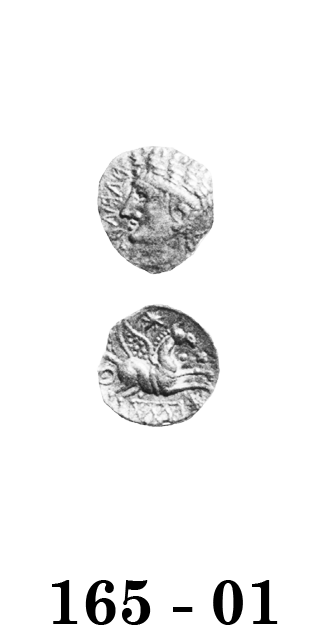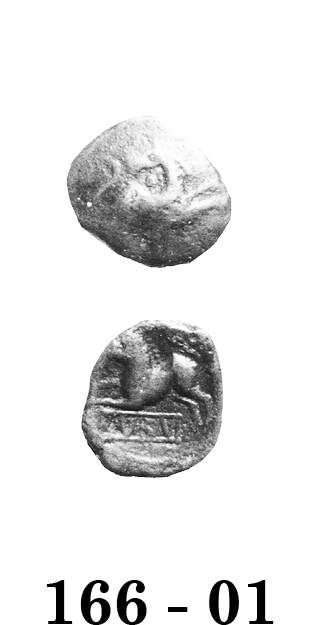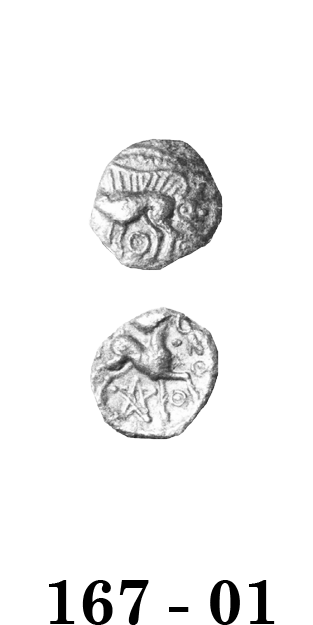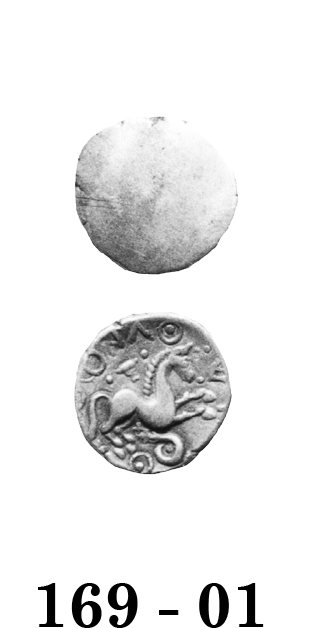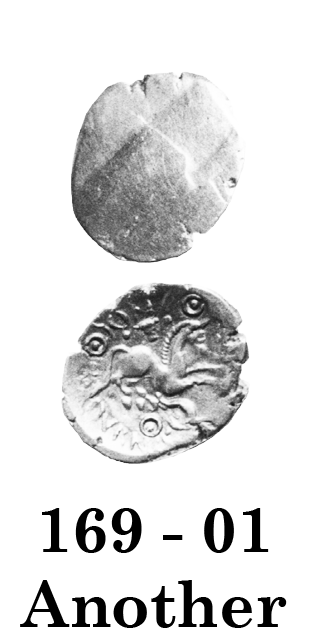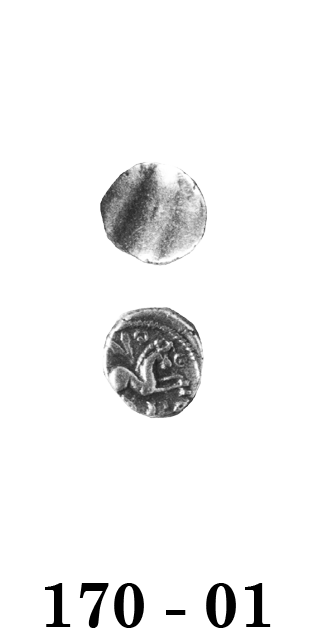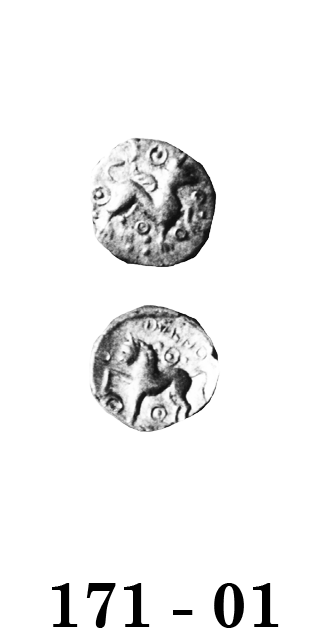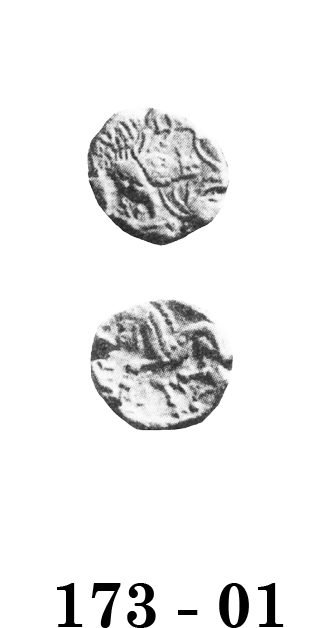
Celtic Coinage of Britain
third edition
Click on coin to see hidden information
Dubnovellaunus in Kent
Dubnovellaunus' coinage is broken down into three separate issues, each having gold, silver and bronze coins. The dating of these is problematic, but the order may be identified by the increasing Romanization of the designs and the influence of the Trinovantian/Catuvellaunian coinage on the gold.
The first coinage staters carry a pellet-in-ring motif on the horse's shoulder, but later coins eliminate it. This mirrors the coinage of the Trinovantes/ Catuvellauni – Addedomaros' third coinage carries the pellet-in-ring motif, but Dubnovellaunus-in-Essex' and Tasciovanus' coins eliminate it. Dubnovellaunus-in-Kent's second coinage adopts the bucranium above the horse from the staters of Tasciovanus.
Several issues appear to have privy-marks and probably all carry some sort of identification which we are unable to recognize today.
Dubnovellaunus in Kent First Coinage
This issue carries the most easily-identified privy marks. The key is that the animals all have pellets under their necks, which disappear on the next issue. Some animals have necklaces and belts, or a curious five-pointed outline star beneath them.
Dubnovellaunus in Kent Second Coinage
The Second Coinage deletes the pellet from below the neck, and the bucranium now appears on the gold. The horse's raised leg on the silver and bronze may be a privy mark. In general, the horses are slightly more Romanized, less abstract, than on the First Coinage. Coin 164-1, also carrying the bucranium, may be a transitional silver type between the First and Second coinages.
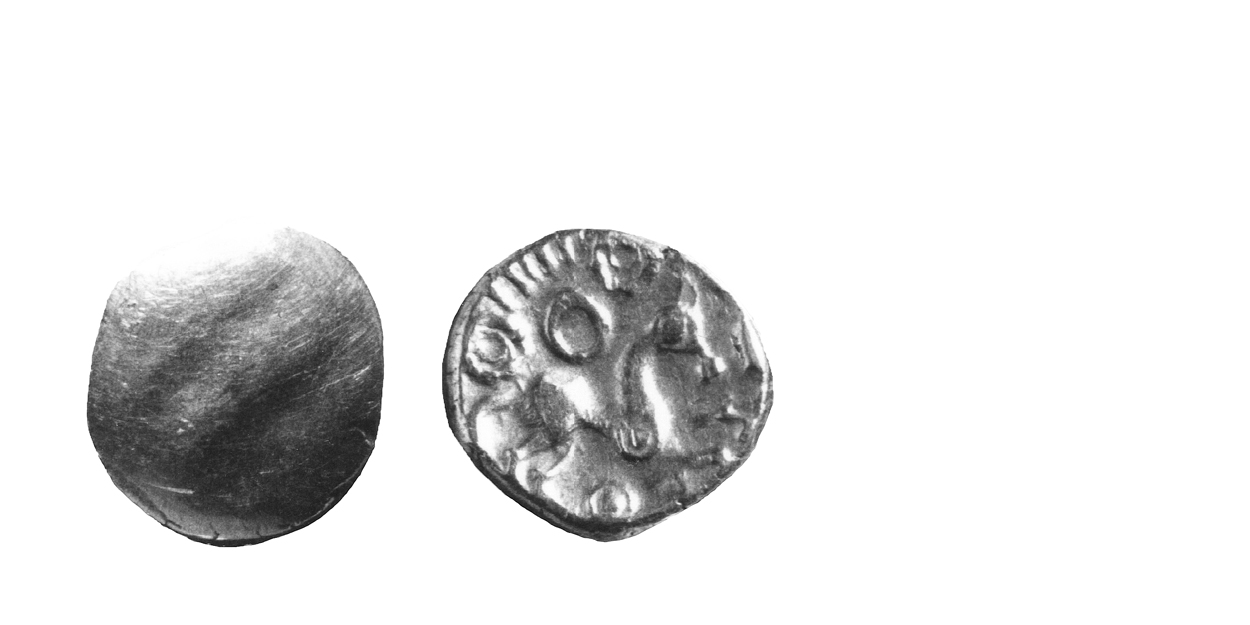
157 - 01 South Thames Banded Type
35-30 B.C. Extremely Rare
Partial Inscription "IVII"
Gold Stater 15 mm 5.6 gms.
Earliest Record: Allen, 1960
OBV: plain, with bands
Identifying points:
1) Three raised bands extend across field
REV: Celticized horse right
Identifying points:
1) pellet-in-ring motif on horse's shoulder
2) pellet-in-ring below horse
3) large ring above horse
4) horse lacks mane
5) partial inscription above horse: probable reading – "IVII"
CLASSIFICATION: Cantian I
NOTES:
- Plate coin reappeared in March, 1987 Muenz Zentrum auction, weight recorded in catalogue
- Actual weight of existing coin given
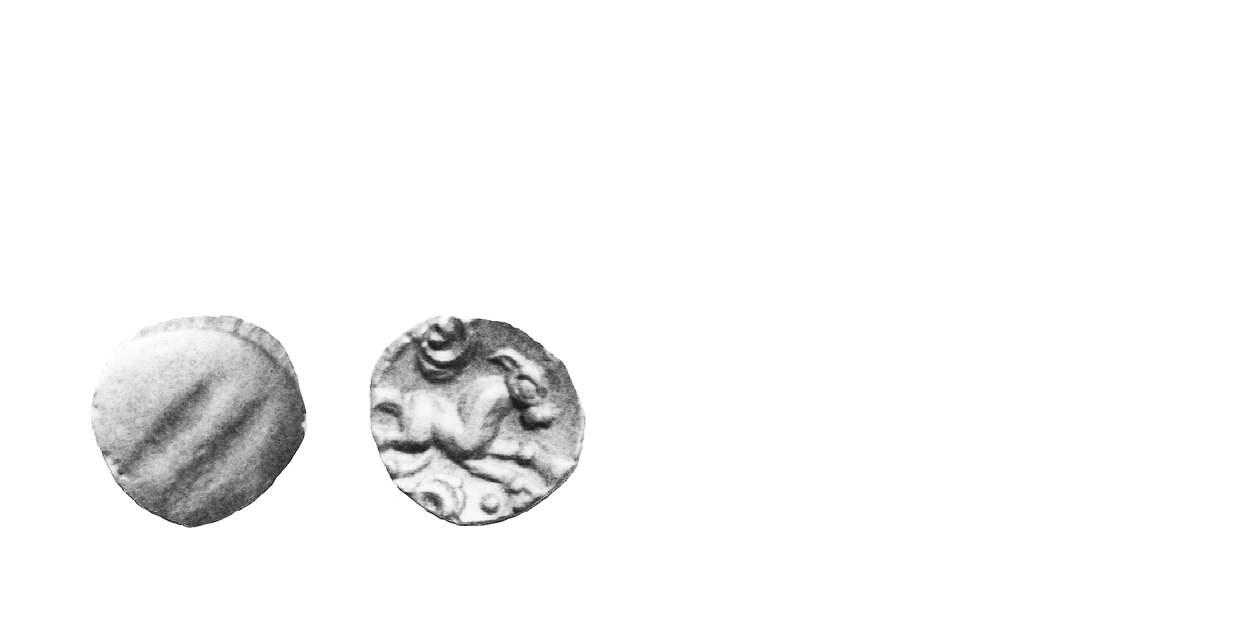
158 - 01 South Thames Banded Type
35-30 B.C. Very Rare
Gold Quarter Stater 11 mm
Earliest Record: Allen, 1960
OBV: Plain, with bands
Identifying points:
1) Three raised bands extend across field
REV: Celticized horse right
Identifying points:
1) large ring above horse
2) horse lacks mane
3) no inscription
CLASSIFICATION: Cantian I
NOTES:
- Most are in museums
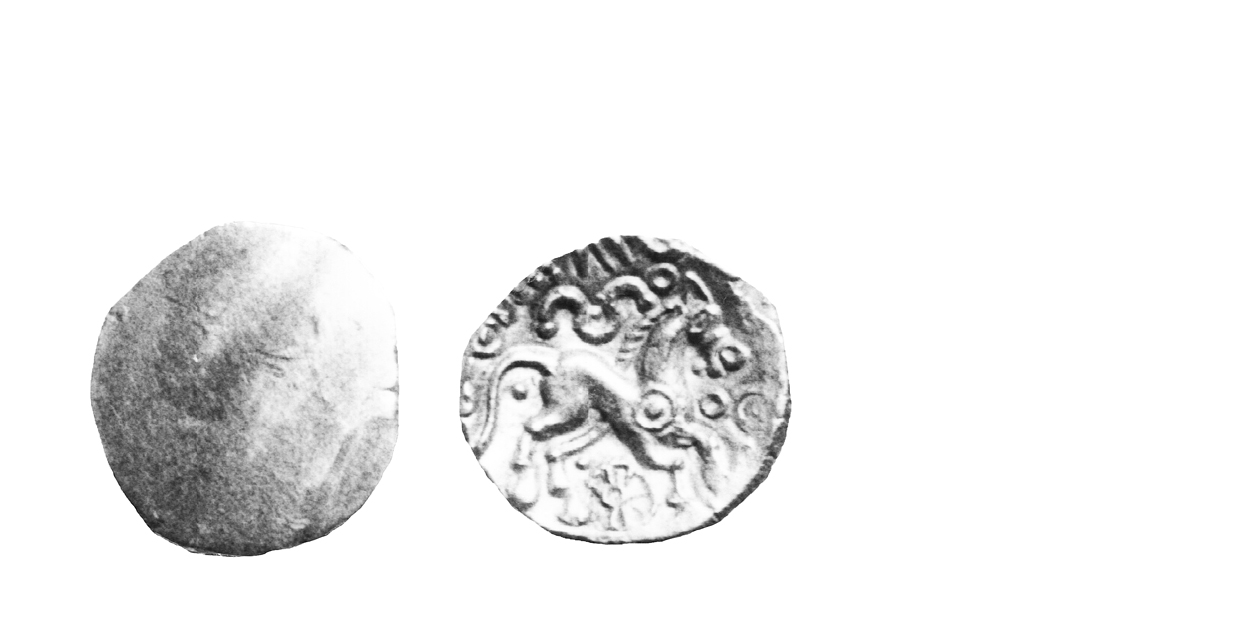
162 - 01 Dubnovellaunus in Kent
30-10 B.C. Extremely Rare
Gold Stater 17 mm 5.4 gms.
Earliest Record: Evans, 1864
OBV: Plain with slight banding
Identifying points:
1) Banding slight – only a raised band across centre
REV: Celticized horse right
Identifying points:
1) pellet under neck
2) Inscription above horse
3) eight-spoked wheel with axle under horse
4) pellet-in-ring on horse's shoulder
5) Yoke-like object above horse
CLASSIFICATION: Cantian J
NOTES:
- Coin is definitely a Dubnovellaunus in Kent type. The inscription is mostly off the flan on all published examples. Allen, perhaps reacting to Evan's report of an Essex origin, read it as 'DIRAS'?', thereby suggesting a Trinovantian/Catuvellaunian origin. Evans noted it similar to coins of Dubnovellaunus and Vosenos, but felt the coin an Essex type because of a Colchester find. He read the inscription as 'DUBORIG'. However, the slightly banded obverse proves it Kentish and the privy mark matches up with the other coins in the series. Speculatively, 'DOBORIG' is 'DUBNOVELLAUNUS RIGONIS', abbreviated.
- Typical weight given
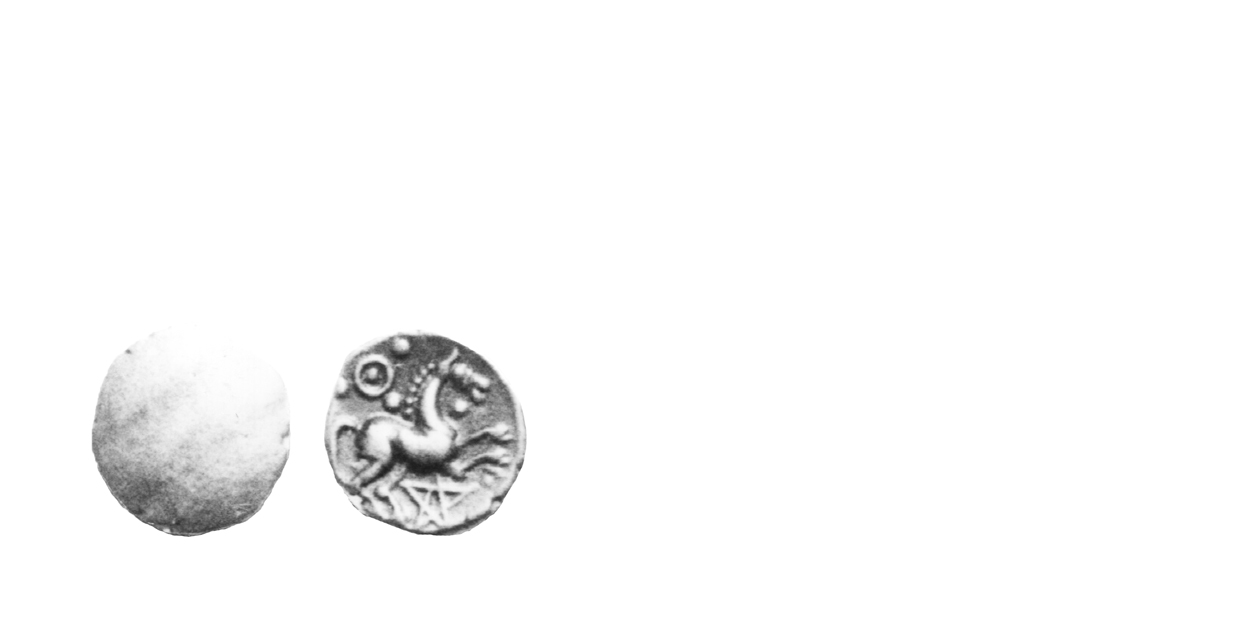
163 - 01 Dubnovellaunus in Kent
30-10 B.C. Very Rare
Gold Quarter Stater 11 mm 1.3 gms.
Earliest Record: Evans, 1864
OBV: Plain with slight banding
Identifying points:
1) Banding slight – only a raised band across centre
REV: Celticized horse right
Identifying points:
1) pellet under neck
2) horse has necklace
3) five-pointed outline star under horse
4) pellet-in-ring motif above horse with three pellets near it
CLASSIFICATION: Cantian J
NOTES:
- Horse possibly has belt
- Typical weight given
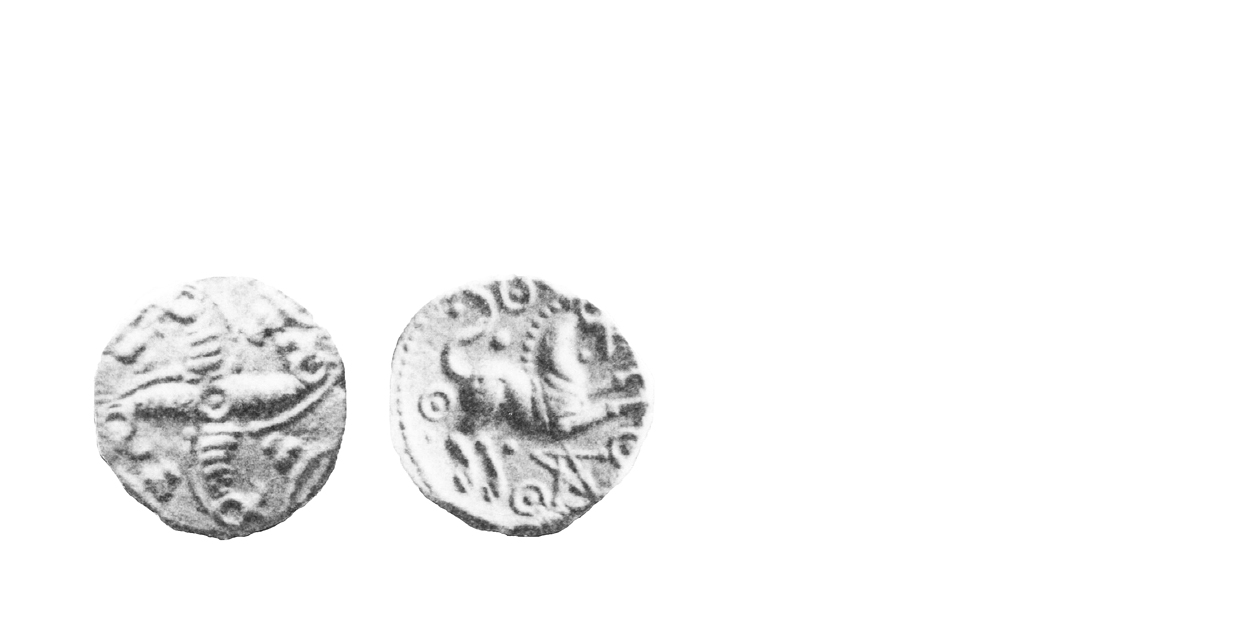
164 - 01 Dubnovellaunus in Kent
30-10 B.C. Extremely Rare
Silver Unit 13 mm
Earliest Record: Allen, 1960
OBV: Serpent-pinwheel
Identifying points:
1) four-armed pinwheel made of serpents
2) pellet-in-ring in centre
3) bucranium in each angle of pinwheel
REV: Celticized horse right
Identifying points:
1) pellet under neck
2) pellet-in-ring motif behind horse
3) horse has necklace and belt
4) five-point outline star below horse
CLASSIFICATION: Cantian J
NOTES:
- Allen described this coin as a "North Thames Type". The privy marks match up with Dubnovellaunus' First Coinage, and the coin may be transitional to the Second Coinage, with the bucranium and wavy tail motifs.
- De Jersey, 2001 notes the meagre number of known findspots are from Essex, Norfolk or Suffolk. It is impossible to determine whether the findspot distribution or the typological analysis is the more reliable indicator in this case. The type possibly may be Trinovantian/Catuvellaunian, but is listed here until further proof is available.
- Most are in museums
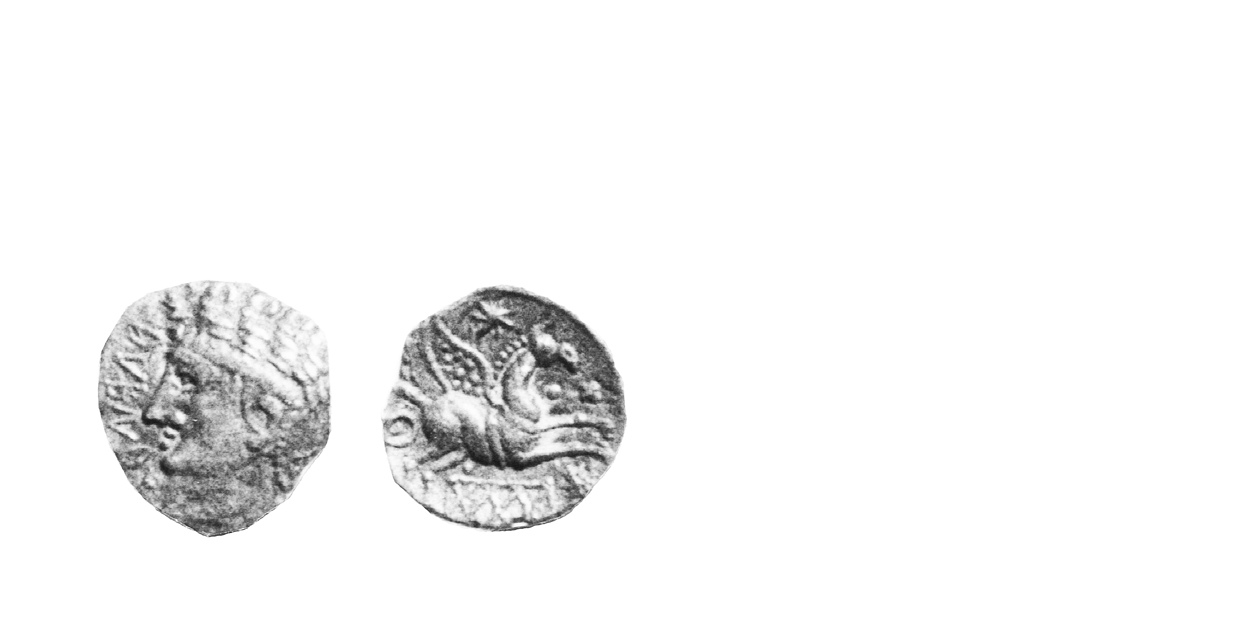
165 - 01 Dubnovellaunus in Kent
30-10 B.C. Extremely Rare
Silver Unit 12 mm 0.9-1.1 gms.
Earliest Record: Evans, 1864
OBV: Celticized head left
Identifying points:
1) DVBNO in front of head
2) head beardless, possibly laureate
REV: Pegasus right
Identifying points:
1) pellet below neck
2) Pegasus has necklace and belt
3) box with cross-hatching below Pegasus
4) asterisks above and below Pegasus
5) pellet-in-ring motif behind Pegasus
CLASSIFICATION: Cantian J
NOTES:
- A coin of Cunobeline copies the reverse type of this coin see 2053-1
- Henig's alternate suggestion the reverses may copy a gem is not problematic – one may be inspired by a gem, and the other copied from it, or both may be derived from similar engraved stones.
- Most are in museums
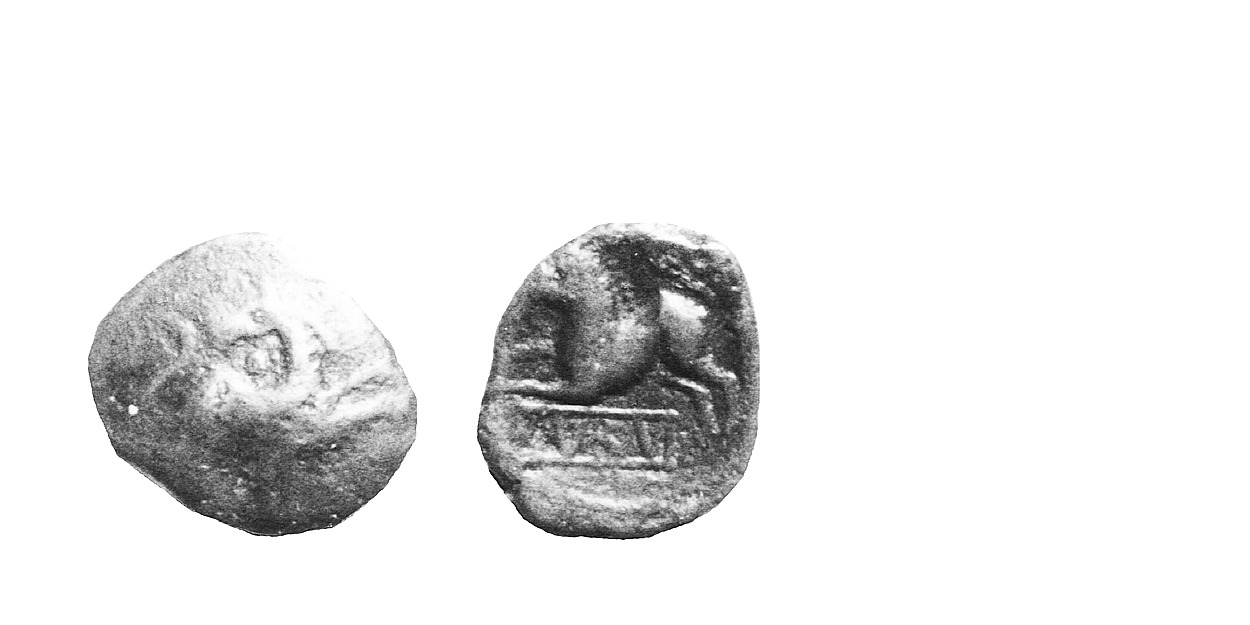
166 - 01 Dubnovellaunus in Kent
30-10 B.C. Scarce
Bronze Unit 15 mm 2.4-2.7 gms.
Earliest Record: Evans, 1864
OBV: Celticized horse right
Identifying points:
1) horse's head turned to rear
2) pellet under neck
REV: Lion left
Identifying points:
1) Box below lion with DVBN
CLASSIFICATION: Cantian J
NOTES:
- A coin of Cunobeline copies the reverse type of this coin – see 2107-1
- Henig's alternate suggestion the reverses may copy a gem is not problematic – one may inspired by a gem, and the other copied from it, or both may be derived from similar engraved stones.
- Most are in museums
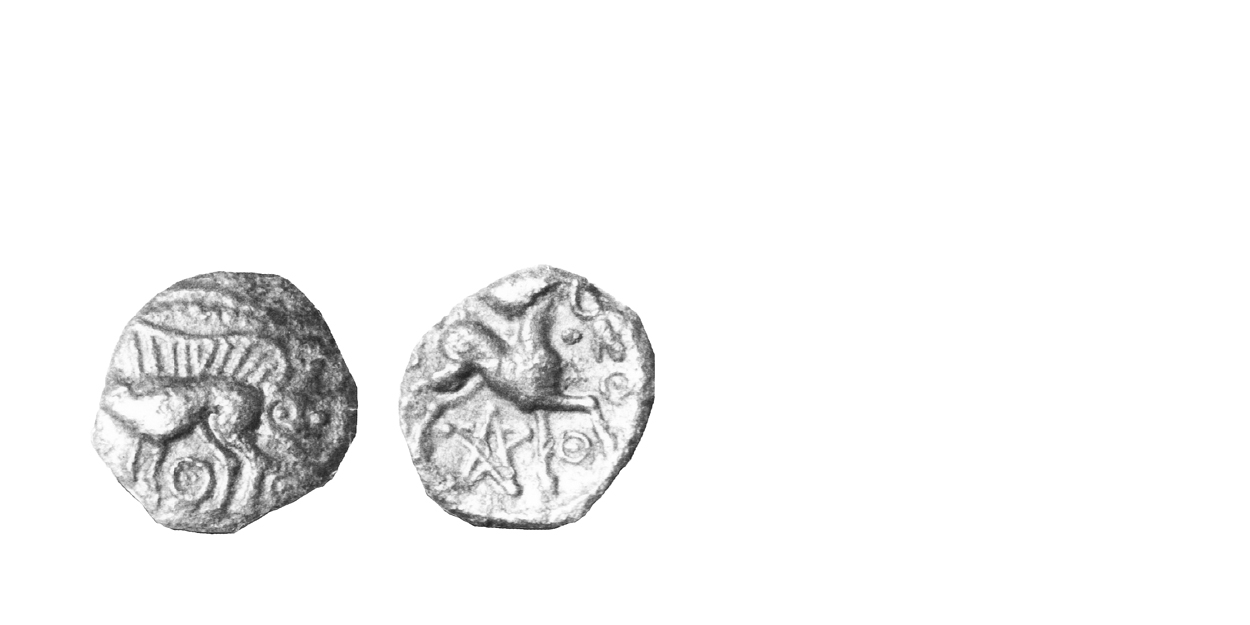
167 - 01 Dubnovellaunus in Kent
30-10 B.C. Very Rare
Bronze Unit 2.1 gms. 14 mm
Earliest Record: De La Tour, 1892
OBV: Celticized boar left
dentifying points:
1) pellet-in-ring motif below boar
2) pellet-in-ring motif near boar's tail
3) pellet near boar's tail
4) wreath above boar
REV: Celticized horse right
Identifying points:
1) five-point outline star below horse
2) horse raises front leg
3) pellet-in-ring motif above and below raised leg
4) pellet below horse's neck
5) horse has necklace and belt
CLASSIFICATION: Cantian J
NOTES:
- Illustrated coin found in Essex in 1979
- Second coin in Bibliotheque Nationale Paris, De La Tour number 8473
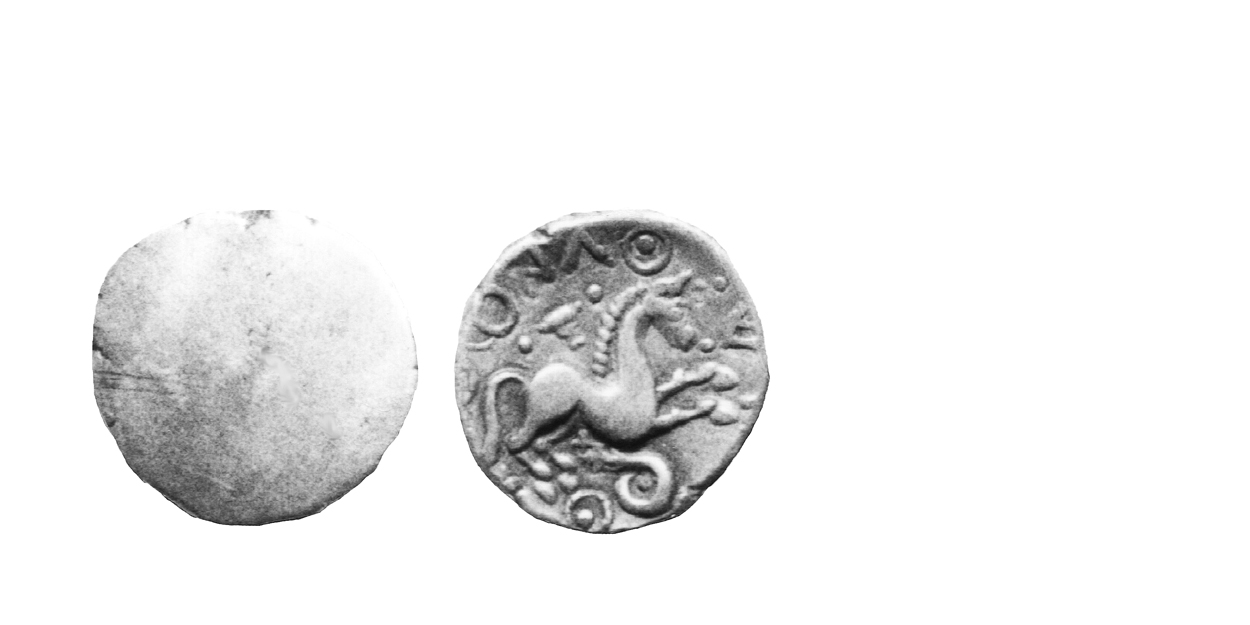
169 - 01 Dubnovellaunus in Kent
30-10 B.C. Rare
Gold Stater 20 mm 5.1-5.3 gms.
Earliest Record: Poste, 1853
OBV: Plain with slight banding
Identifying points:
1) banding slight only a raised band across the centre
REV: Celticized horse right
Identifying points:
1) inscription above horse
2) bucranium between horse and inscription
3) pellet-in-ring motifs above horse's head and behind and below animal
CLASSIFICATION: Cantian K
NOTES:
- Typical weight given
- The standard weight (which should be about 5.6 gms.) is probably not revealed because of the small number of recorded weights
- Inscription DUBNOVELLAUNUS, probably, but uncertain if complete legend actually appears
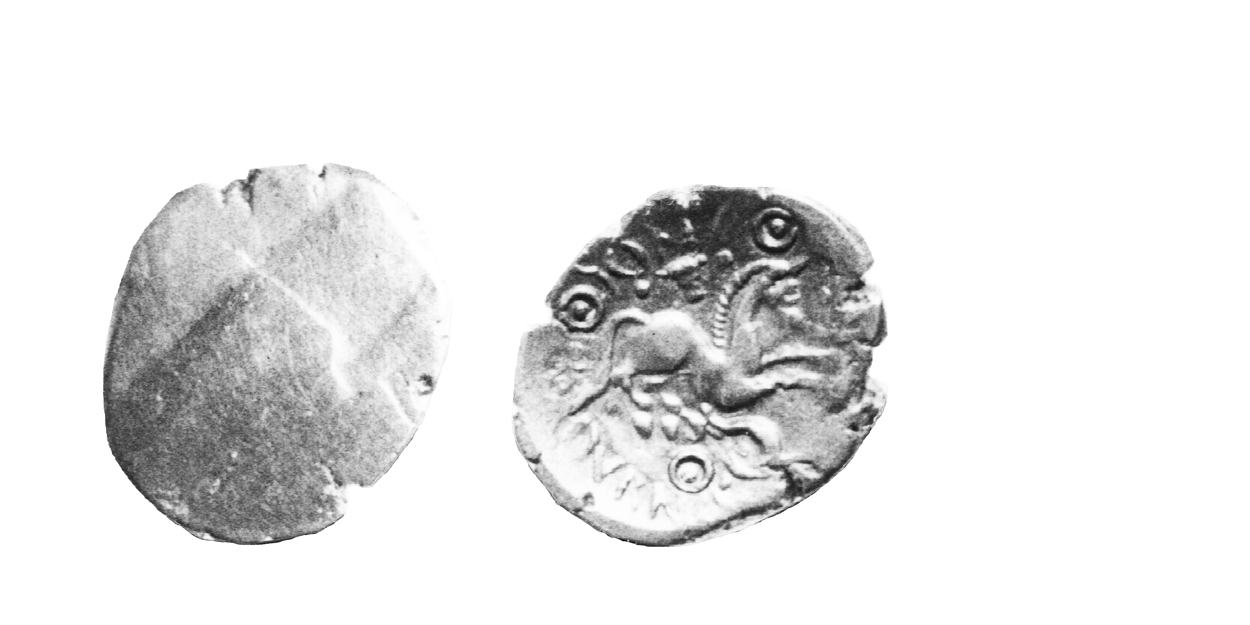
169 - 01 Dubnovellaunus in Kent
30-10 B.C. Rare
Gold Stater 20 mm 5.1-5.3 gms.
Earliest Record: Poste, 1853
OBV: Plain with slight banding
Identifying points:
1) banding slight only a raised band across the centre
REV: Celticized horse right
Identifying points:
1) inscription above horse
2) bucranium between horse and inscription
3) pellet-in-ring motifs above horse's head and behind and below animal
CLASSIFICATION: Cantian K
NOTES:
- Typical weight given
- The standard weight (which should be about 5.6 gms.) is probably not revealed because of the small number of recorded weights
- Inscription DUBNOVELLAUNUS, probably, but uncertain if complete legend actually appears
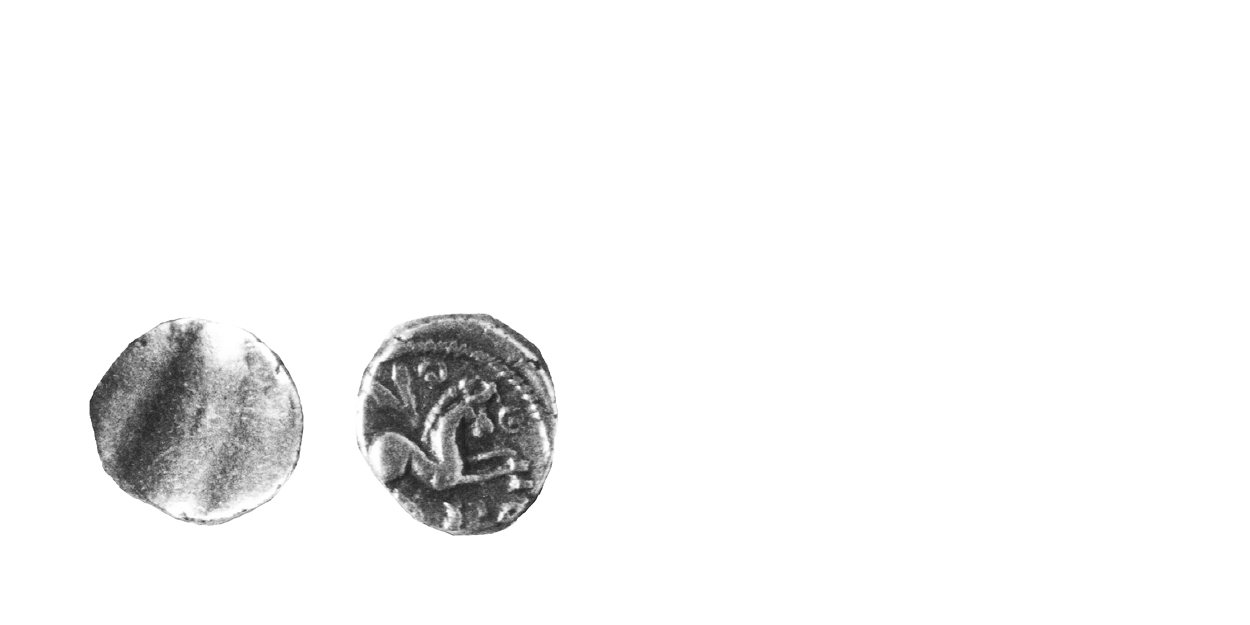
170 - 01 Dubnovellaunus in Kent
30-10 B.C. Rare
Gold Quarter Stater 12 mm 1.1-1.3 gms.
Earliest Record: Evans, 1864
OBV: Plain with slight banding
Identifying points:
1) banding slight – only a raised band across the centre
REV: Celticized horse right
Identifying points:
1) rings above horse's head and tail, and in front of animal
2) 'V-shaped' object above horse (disintegrated bucranium)
CLASSIFICATION: Cantian K
NOTES:
- Typical weight given
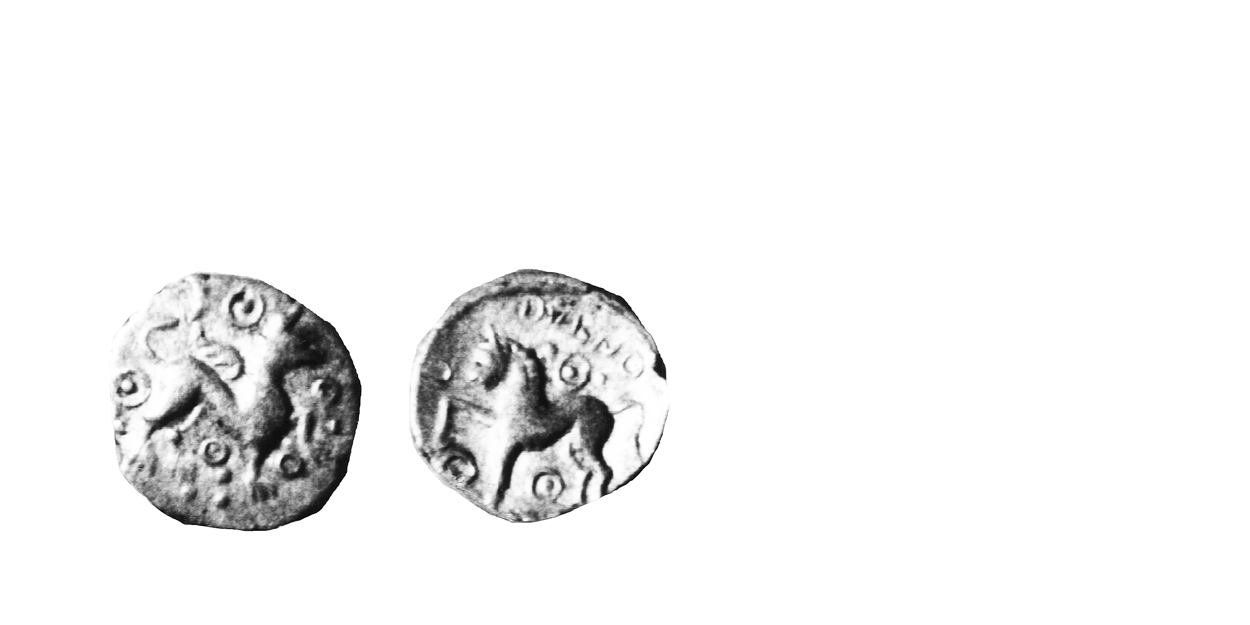
171 - 01 Dubnovellaunus in Kent
30-10 B.C. Very Rare
Silver Unit 13 mm 0.7 gms.
Earliest Record : Evans, 1864
OBV: Uncertain animal right
Identifying points:
1) DVBN inscription
2) pellet-in-ring motifs above and behind animal
3) wavy tail as on 164-1
REV: Celticized horse left
Identifying points:
1) pellet-in-ring motifs above, below and in front of horse
2) horse's right front leg raised
3) DVBNO above horse
CLASSIFICATION: Cantian K
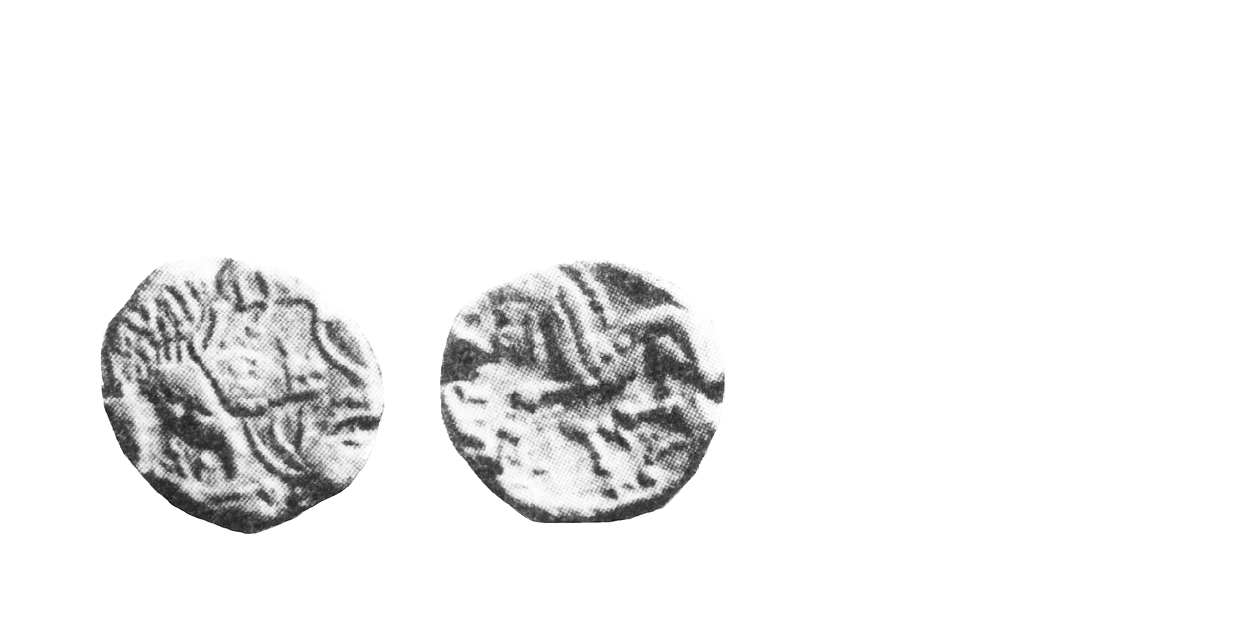
173 - 01 Dubnovellaunus in Kent
30-10 B.C. Extremely Rare
Bronze Unit 15 mm 2.6 gms.
Earliest Record: Mack, 1964
OBV: Boar right
Identifying points:
1) DVBNO above boar
REV: Celticized horse left
Identifying points:
1) horse's right front leg raised
CLASSIFICATION: Cantian K
NOTES:
- A Gaulish origin has also been claimed for this coin
Kentish Dynastic Coinages
The first inscribed coins carry an illegible inscription, mostly off the flan on existing pieces. The letters 'IVII' partially appear on one stater, but the reading is uncertain. Hopefully, future finds will enable the full inscription to be read.
The next series of inscribed coins are those of the Kentish Dubnovellaunus, probably a different ruler from the one in Essex. Dubnovellaunus-in-Kent struck coins from about 30 B.C. up to the Trinovantian/Catuvellaunian Interregnum, about 10 B.C. At this point, he was replaced by a short-lived ruler, Vosenos, who was in turn replaced by Eppillus of the Atrebates/Regni/Belgae. Eppillus, sensing a loss of Trinovantian/Catuvellaunian influence, intervened in Kent only to be later driven out by Cunobeline. Eppillus issued special coins for use in Kent; subsequently, Cunobeline's coinage circulated. Between the death of Cunobeline and the Claudian invasion, the brief issues of Amminius appeared.
All Kentish dynastic coinage is extremely rare, with only a few examples of each type known today. The issues must have been small, and would be relatively unimportant except they identify the names of Kentish rulers. For the most part, the economic influences of the Trinovantes/Catuvellauni, and for a short time the Artebates/Regni/Belgae were the significant factors in Kent.
